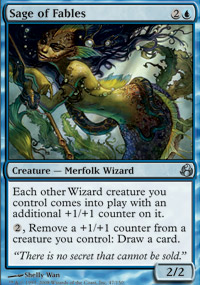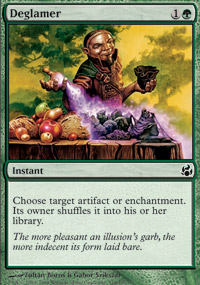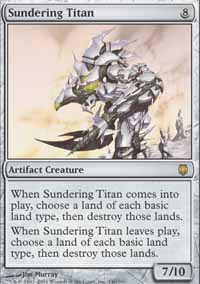
Cranial Insertion
More Than Morningtide
by Eli Shiffrin, Tom Fowler, and Ted Dickinson
More Than Morningtide
by Eli Shiffrin, Tom Fowler, and Ted Dickinson
The Prereleases are behind us, and the
You can send us your questions to [email]cranial.insertion@gmail.com[/email]. We’ll answer it for you, and probably post it here for all the world to see. We promise not to call you a n00b and make your friends hit you with sticks for asking the question you did, though. Unless you’re a masochist and into that sort of thing. You n00b.
A few of these came from my local Prerelease, which is always a good place to find questions for the column. Let’s see what we have this week . . .

CONTROVERSY~!
A: The [O]fficial answer, given by each of the NetReps, is yes.
This is not supported in the Lorwyn Comp Rules, so expect there to be a change in the Morningtide version when the set is officially released. (Note, however, that the official ruling means that it works right now and does get counters. No rules cheese plz.) The reason it’s not supported with the current version is that “as ~this~ comes into play” replacement effects only take copiable values into account; the changeling ability is copiable, but not the plethora of creature types associated with it.
Our best guess is that as-CIP replacement effects will look at characteristic-defining abilities in addition to copiable values. That’s only a guess, though.
Q: I thought at the beginning of your upkeep, each of your kinship creatures triggered. And when one of those triggers resolved, you looked at the top card of your library and could reveal. If you did, the effect would happen. At the Prerelease, the judge said you could just look at the top card in your upkeep and choose to reveal. If you did, a trigger would go on the stack for every creature in play with kinship that shared a type to cause its effect.
I wasn't really satisfied with the explanation; could you tell me how it works exactly?
A: You understand kinship correctly. At the beginning of your upkeep, each creature with the kinship ability sees that ability trigger. Since you control them all, you put those abilities on the stack in whichever order you choose. The resolution of the ability is to look at the top card, maybe reveal it, and get some effect if you do. That’s all one ability, so your opponent doesn’t get a chance to respond if you revealed a creature type that benefits you.
Q: I have a Pyroclast Consul and a Squeaking Pie Grubfellows. My opponent has a Kithkin Healer. If I reveal a Shaman, can my opponent still respond by preventing damage?
A: No, at that point, it’s too late for your opponent to prevent the damage. He would have to use the Healer’s ability while the Pyroclast Consul’s kinship ability was still on the stack.
Q: Also, if my Grubfellows die, does my opponent still discard a card?
A: If Squeaking Pie Grubfellows die before the kinship ability resolves, the game will use last-known information to determine if the revealed card matches its creature types. The exception is if the Grubfellows die to Nameless Inversion; then LKI remembers a creature with no types, and you’re probably not going to find a match for that.
Q: So I can’t “interrupt” kinship by using Amoeboid Changeling’s ability to make the creature with kinship lose all its types?
A: Nope. Once the ability has started to resolve, it has to finish before either player can play anything. You can respond to the kinship trigger with Amoeboid Changeling’s ability, though, which means the creature will have no creature types when its kinship ability resolves.

Is a glamer like a dwoemer?
A: It’s just asking you to choose a target. A modal spell begins with “Choose one—“ or “Choose two—“. If your Loxodon Warhammer is facing a sudden deglamering, you can use Willbender to change that target to any other enchantment or artifact that Deglamer could target. Fertile Ground seems like a fair trade.
Q: I have Greatbow Doyen, Essence Sliver, Mirror Entity and Enormous Baloth in play. I have only a single mana available. I attack with the Baloth, and my opponent blocks it. With 7 damage on the stack, I activate the Entity for 1, turning the Baloth into a 2/2 Archer Sliver. How much life will I gain, and how much damage will be dealt?
A: Despite the fact the Baloth has become rather puny, it put 7 damage on the stack. The game will use its current information to determine what it needs to know about the source of that damage. And since it’s now an Archer, your opponent takes 7 to the face.
The lifegain, though, depends on whether the now-puny Baloth survives combat. If it does, you’ll gain 7 life for the damage the Doyen makes it deal. If the Baloth-Archer dies in combat, the lifelink trigger doesn’t exist at that time, so it won't trigger and you won't gain life. Either way, you'll gain 7 life for the combat damage.
Q: Also on Greatbow Doyen—if an Archer deals damage to an indestructible creature with Pariah on it, is that an infinite loop? What do you do then?
A: Start shuffling for the next game. That is indeed an infinite loop, since there are no options within the loop that could be used to break it. The current game ends in a draw.
Q: Can my opponent kill my 2/2 Taurean Mauler with Sudden Shock?
A: Nope. The triggered ability to add a counter will go on the stack on top of the spell, so the Mauler will have the +1/+1 counter before damage is dealt. Split second is a nice ability, but it doesn’t stop triggered abilities from triggering.
Q: How does Knowledge Exploitation interact with Mind Shatter? Do you have the option to pay for the and the is free?
A: The is free. Unfortunately, so is the , which means you can’t pay anything for it. Whenever you play an X spell without paying its mana cost, the only possible value for is 0.
From the CR glossary:
X
If a spell or activated ability has a cost with an “{X}” in it, the value of X must be announced as part of playing the spell or ability. (See rule 409, “Playing Spells and Activated Abilities.”) While the spell or ability is on the stack, the {X} in its mana cost equals the amount announced as part of playing the spell or ability. If a card in any other zone has {X} in its mana cost, the amount is treated as 0. If you’re playing a spell that has {X} in its mana cost and an effect lets you play it without paying any cost that includes X, the only legal choice for X is 0.
Q: If I Twincast an opponent’s Profane Command, or any other card with in the mana cost, how does it work? Do I copy the spell and pay my own cost? Copy the spell exactly, including what my opponent payed for ? Or do I copy the spell and not get the opportunity to pay at all, thus making the spell useless?
A: When you copy a spell, the choices made when it was initially played are copied. This includes mode(s), the value of , targets chosen (which can usually be changed—it would rather suck if you had to Fireball yourself when you copied spells like that), etc. With Profane Command, that means you’re locked into the modes and the value of X, but you can change any targets the spell asks for.
503.10. To copy a spell or activated ability means to put a copy of it onto the stack; a copy of a spell or ability isn’t “played.” A copy of a spell or ability copies both the characteristics of the spell or ability and all decisions made when it was played, including mode, targets, the value of X, and optional additional costs such as buyback. (See rule 409, “Playing Spells and Activated Abilities.”) Choices that are normally made on resolution are not copied.

And the trees are all kept equal
by hatchet, axe, and saw.
A: Many lands go boom. Your opponent cackles evilly, mainly because he played a 7/10 creature that Stone Rained your lands for the bargain cost of and the sacrifice of a Mox. You begin thinking that a four-year forced vacation from sanctioned play might be worth punching him in the face.
If you want specifics, then the Titan’s ability asks you to choose a land of each basic land type. This can be an actual basic land, or a card like Hallowed Fountain, which is not a basic land, but still has basic land types. If a basic land type is not represented by the lands in play, then you can’t choose it. If it is, you have to choose it, even if it’s one of your lands—if you have the only forest in play, Sundering Titan is taking an axe to it.
Q: Let’s say Titan comes into play when my opponent has Cabal Coffers, Forest, Swamp, and Overgrown Tomb. What can I make him sacrifice?
A: Well, Coffers has no basic land types, so that’s out. You can choose Swamp or Forest for Overgrown Tomb. (You can also choose it as a Swamp and choose it as a Forest; that’s suboptimal strategically, but perfectly legal.) You can choose the basic Swamp and Forest. If you choose Overgrown Tomb as one of its types, then you can choose the other type of basic land along with it.
Q: What if my opponent is playing Affinity and has only artifact lands?
A: Unless those lands have somehow acquired basic land types, you can’t choose them. This means Sundering Titan will be blowing up some of your lands, while leaving your opponent’s unscathed.
Q: With the following mana base:
What’s the maximum amount of you can pay for Engineered Explosives? Can you pay one U, one W, and one colorless and sacrifice it for 3?
A: Engineered Explosives is an X spell. That means you can pay any amount of mana for it. It will only get a charge counter for each color of mana you spend, though. With that mana base, you can pay approximately eleventy thousand for X. Since the only colors you can make are U and W, though, you’re only going to get 2 charge counters.
Q: Does an Engineered Explosives with 0 counters destroy an animated Treetop Village?
A: The Apes are shielded from this blast. Even though the Village is cleverly disguised as an ape, it’s still a land. Engineered Explosives is quite incapable of destroying lands.
Q: How do Guile and conditional counterspells interact? If I pay for Mana Leak, does my spell still get removed from game with Guile?
A: If you pay :3mana:, the spell isn’t countered, so Guile won’t have anything to do with it. If you don’t pay, then Guile flaps his useless wings (a trait shared by at least one other winged creature that somehow doesn’t have flying), reaches down, and grabs the spell for his own evil purposes.
Q: When can I play reinforce?
A: It’s an activated ability with no inherent restrictions on when it can be played. Ergo, you can play it any time you could play an instant.
Bonus: Here’s an amusing anecdote from our Morningtide Prerelease. Over the course of the day, about 90% of the judge calls we got were for one of the following three things:
- When can I play reinforce?
- Does one Banneret reduce the cost of this spell that matches both its types by or ?
- Do Bannerets reduce the cost of the spell if I pay the prowl cost?
The answers are: as an instant, by , and yes. As the day wore on, I jokingly proposed some pre-emptive judging. My suggestion was that a judge, upon arriving to a table, would say, “Hi, guys. Before you ask . . . you can play reinforce as an instant, a single Banneret can only reduce a spell by , and Bannerets do reduce the cost if you use prowl. Does that answer your question?” Well, during one of the last sealed flights of the day, one of the judges decided to use this strategy, and it worked. I think he was 3-for-3 with it. I didn’t seriously advocate using it, but it worked, and all parties involved thought it was spiffy, so I guess that’s a win-win.

Hi, we're looking for The Great Muta.
A: Then its landscape is pockmarked by the dice or beads you stuck on it. It retains the +1/+1 counters, even though they’re irrelevant to its type. When it animates again, however, the +1/+1 counters will apply again.
Q: My opponent has a Stenchskipper (tapped) and one goblin. I attack with Galepowder Mage and remove the goblin with its ability. At end of turn, what happens?
A: Two triggers will go onto the stack: Galepowder Mage returning the removed creature to play, and Stenchskipper flailing and crying at being abandoned by his goblin friends. Since they’re controlled by different players, they’ll go onto the stack in active player, nonactive player (APNAP) order. This means your Galepowder Mage trigger goes first, then Stenchskipper. Presuming no responses, Stenchskipper’s ability will resolve, see no goblins, and send itself to the graveyard. Galepowder Mage will then return the removed goblin to play.
Somewhere, Stenchskipper is howling in frustration.
Q: I have a creature enchanted with Reins of the Vinesteed. My opponent blasts it with Shriekmaw. In response, I play Graceful Reprieve on my creature. Can I end up with the same creature in play, enchanted with the same Reins of the Vinesteed?
A: You can. When Shriekmaw kills your creature, it will go to the graveyard. State-based effects will send the Reins packing right behind it. Two triggers will then go onto the stack (Reprieve and Reins), and you can stack them in whatever order you choose. If you resolve Graceful Reprieve first, the creature will return to play. Then Reins of the Vinesteed’s ability will resolve, and you can return it to play attached to the same creature.
Q: Do Morningtide cards really become legal when they’re officially released?
A: Yup. This was a policy that changed not long ago. Sets are now legal on their official release date, not the 20th of the month. This means you can play in your Morningtide
That’s all for this week. Next week: Funeral Pyre wonders when a set is going to be named after it.
-Tom Fowler
Comments